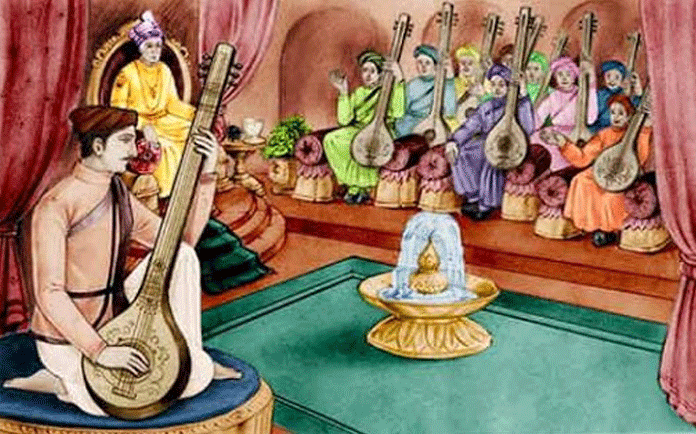Sree Ragam-2
We have seen how ‘swaras’ or notes were created inspired by the sounds in nature in the previous article. Raga and Rhythm, are the lifelines of Indian Classical music. A combination of ‘swaras’ produce musical notes known as ragas. ‘Rang’ in Sanskrit denotes colour or passion and the word raga derivedfrom ‘Rang’, connotes colour and aesthetic appeal.
A raga can be broadly defined aesthetically as a tapestry of ‘swaras’ woven intricately into a beautiful pattern. A raga has a distinctive identity, a soul and a purpose. The ‘swaras’ encompassed in a raga express the quality, mood and the nature of the raga.
Uniqueness of Raga
The absolutely unique personification of the ragas exclusive to Indian Classical music can be attributed to the fact that it draws the inspiration from our vedas; the classification of dynamic and static states as Prakruti and Purusha.
Ragas have been personified as feminine and masculine as well; The Rag- Ragini classification of ragas is prevalent in Hindustani Classical music and in Carnatic Classical music, it exists, theoretically. Ragas are further classified into morning, noon, evening and night ragas. Specific ragas were created to depict the seasons of the year.
Characteristics of a Raga
A Raga cannot be literally translated into English as a melody, scale or notation, as there are certain characteristics imperative for the creation of a raga,
A Combination of notes, similar to the western solfege
A modal structure, known as ‘mela’in Carnatic music and ‘Thaat’ in Hindustani Music
An ascending and descending order of the ‘swaras’ exclusive for each raga, known as ‘Arohana’ and ‘Avarohana’ respectively.
Resemblance to Western Solfege
In western classical music, compositions are based on scale. The solfa system of do re mi fa sol la ti do corresponds to our sa, ri ga ma pa da ni and resembles Sankarabharanamragam of Carnatic Classical music.
Tansen and Rag Deepak
To depict the power of a raga here is an interesting legend of Tansen. He was one of the nine jewels in the court of Emperor Akbar and a greatest musician. To prove his calibre, once Akbar ordered him to light candles in the court with his singing prowess. Tansen was a musician who had in-depth knowledge about ragas. He decided to render Rag Deepak, but was afraid that the immense heat produced with the rendition of Deepak rag would burn him to ashes. To nullify the effect, he taught his daughter Rag MeghMalhar, which could induce rain. As anticipated, Deepak rag created heat and warmth after Tansen performed for a certain duration before an invited audience. With the progression of the raga, flames erupted and engulfed the surroundings. Saraswathi, daughter of Tansen doused the flames with the rendition of Rag MeghMalhar.
Also Read: Understanding Music
Ragas in our film music
Our popular Bollywood and other film songs solely rely on ragas for composing the tunes.
Bollywood and other film music can be exemplified as the most popular genre of music in India. The articulation of the ragas would be dealt subtly in film music. Prominence is accorded to lyrics and orchestration.
The evolution, popularity, and sustenance of film musiccan be accredited to the source, i.e. Indian classical music.
To reminisce about a few film songs based on various ragas;
‘LagaChunarimeindaag’ is based on Rag Bhairavi
‘AlbelaSaja Ayo Ri’is based on Rag Bhupali
‘Khilte Hai Gul Yahan’is based on Rag Bhimpalasi
“Neevundeda Konda pai” is based on Ragam Ananda Bhairavi
“EvaruNerperammaEeKomakku” is based on RagamBilahari
“Siva SankariSivanandalahari“isbased on RagamKanada
“Sankara Nada Sareera Para” based on RagamMadhyamavathi……
“SadaNannuNadipe nee chelime” based on RagamKhambojhi
The Raga and the Artist
Whether it is singing or playing an instrument, it is the oscillations and waves of the ‘swaras’ that exude the charm and identity for the raga. An artist who puts in heart and soul in understanding the bhava or emotion of the raga can portray the ‘swaras’ effortlessly just as a painter colourfully paints the canvas and enraptures the listeners.
Late Dr. M Balamurali Krishna, a renowned music composer par excellence, had special adoration for RagamKalyani. He literally mastered the raga to an extent, where, in his self-proclaimed words, “wasbestowed with the glimpse of Kalyani raga devatha or the deity!”
An ardent musician in his soulful musical journey would develop a passion and attachment for a particular raga and devotes his life in seeking perfection of the raga. When the nectar of ‘swaras’ flow through the raga, it is a feast for passionate music lovers who long to relish the ambrosia.





An informative article on Raga for all the enthusiasts of the music.
Excellent